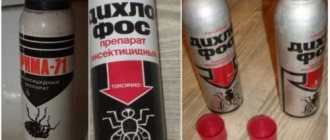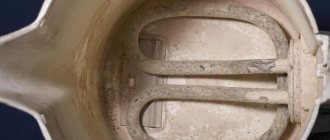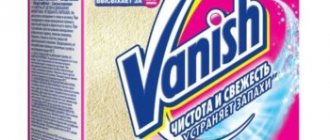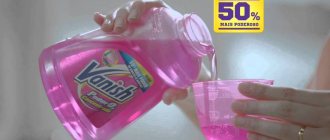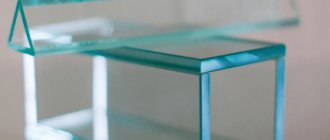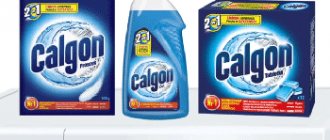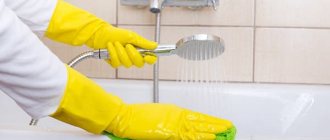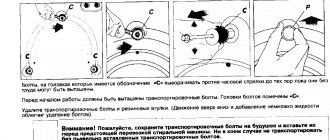Updated: 07/11/2021 16:13:31
Despite the fact that nowadays the choice of detergents and powders is very wide, many housewives prefer to use simple household products such as soda, vinegar, citric acid, etc. Soda has many advantages - it has excellent cleansing, deodorizing, disinfecting qualities, it is safe for the human body and costs almost a penny. These properties of soda allow you to get the desired result when cleaning and carrying out other activities, as well as save money on the family budget. One of the uses of soda is washing clothes. In this article, we will look at what can be washed with this product, how to do it correctly, and whether soda can be used in modern washing machines.
Preventive measures
By forgetting to clean your washing machine regularly, you increase the risk of plaque and mildew. The machine may fail before the end of its service life. To increase the service life of the machine, do not forget to clean it at home with soda and vinegar. To avoid unpleasant odors, remember the following steps:
- Try not to pour too much detergent: this will not help to wash things perfectly, and the remaining powder will settle on the walls inside.
- Do not keep the machine loaded with dirty laundry for a long time.
- Start the process immediately after downloading.
- After washing, remove items and do not leave them wet inside the drum.
- Open the machine periodically to dry it.
To prevent the appearance of scale and limescale, do not forget:
- Wipe accessible parts dry each time after washing.
- Place a good filter at the water inlet to the apartment so that liquid without impurities enters the drum.
- Before washing, remove all small items from your pockets and fasten zippers and buttons.
- Do not place old, worn-out items in the machine.
- Do not wash jackets and sweaters that are too fluffy.
- Periodically turn on the machine without laundry, pour a little powder into the tray, and run it empty.
The effect of chemistry on the body
In fact, household chemicals have already become firmly established in our daily lives. Not a single housewife can imagine how she would cope with all her worries if she were deprived of her treasured powders, gels and other “terrible chemicals” even for one day. All these substances are a product of progress; it would be stupid not to use them, but to continue going to the river and washing clothes there at any time of the year. But with all this, you should carefully monitor the composition of this or that product.
:
- New substances are synthesized regularly.
- It takes too much time to complete lengthy checks.
- Sometimes it is only decades later that clients learn about the long-term consequences.
- They are usually associated with neoplasms or disorders of fetal development.
These are already quite good reasons to spend money on high-quality household chemicals and buy only time-tested products
.
If the packaging contains any abbreviations or numbers, do not be lazy to look for full explanations on the Internet. Often hidden behind this are not the safest components.
How to clean a washing machine with soda
When there is a need to clean your washing machine, you look for effective ways.
Most people know that baking soda has a good ability to remove dirt from various surfaces. In the household, it is used not only for cooking, but also for various household purposes.
In addition to food dirt, calcined dirt is used to remove dirt. Washing soda is also popular for washing in the washing machine.
Next, we will look at the question of how to clean a washing machine with soda, and we will tell you a lot of useful information that will be useful to you more than once.
What is the difference between soda ash and baking soda?
Three types of this alkali are used in various fields of activity:
- Caustic. It is considered the strongest in chemical composition. It is practically not used for domestic purposes; it is in demand in the chemical industry.
- Soda ash is the most suitable option for washing. With its help you can easily clean your washing machine. Sold at any household chemical store.
- Food grade – a weak alkaline product, in demand in the confectionery industry.
Let's consider the question of how to clean a washing machine with soda and how to use it when washing.
Yes! Even for clothes it is an effective remedy.
Use as a laundry deodorant
Washing with baking soda in the washing machine is a great way to remove old stains from clothes and get rid of unpleasant odors. It is enough to soak the item overnight in a soda solution.
What is washing soda? This is a product that is often used to clean a washing machine, remove scale from the heating element, and remove stains from clothes.
There is one effective method used for washing kitchen towels:
- Mix a pinch of calcined salt with grated laundry soap.
- Place in an enamel container and fill it halfway with water. Wait until completely dissolved.
- Place the towels in water and boil for 20 minutes over low heat.
- Wash the towels in the washing machine, adding powder.
Baking soda in an automatic washing machine is an excellent tool that can be used to keep your home clean, remove dirt from clothes, rid things of unpleasant odors, and clean household appliances.
Cleaning the washing machine
First, let's look at a method for cleaning a washing machine with citric acid and soda.
You will need 150 g lemon powder and 10 g soda ash. The mixed ingredients must be added to the powder compartment. After this, you should set the washing mode to high temperature and start the washer.
Important! This mixture helps to efficiently and effectively remove stubborn limescale from faucets! Plaque is also removed from parts of the SMA using the same principle. To the question, is it possible to clean a washing machine with soda, the answer is yes
You can use it to clean the drum and other parts.
To the question whether it is possible to clean a washing machine with soda, the answer is yes. It can be used to clean the drum and other parts.
For example, the tray is most susceptible to the accumulation of large amounts of soap and limescale. Cleaning the tray is very simple: apply a small amount to the tray and rinse with water after a while.
Plaque and scale can lead to serious damage to the washing machine. If you do not take care of your washing machine, then after a while you will notice an unpleasant odor from the drum. It is recommended to use baking soda to thoroughly clean the washer. Unlike specialized products, it is low cost and effective.
To remove mold, plaque and fungal growths, go through five steps:
- Mix 50 g of soda and 50 ml of water.
- Apply the resulting mixture to the drum and rubber seal, since this is where mold forms.
Wear rubber gloves as the lye causes dry hands and causes irritation. - Wait half an hour for the solution to take effect.
- Take a cloth and wipe the dirty areas in the drum.
- Turn on the empty machine, selecting the fastest wash program.
Soda is a universal remedy that allows you not only to run a household, but also to wash things, clean kitchen surfaces, and remove unpleasant odors.
Of course, the answer to the question is it possible to add soda to the washing machine - you can! If you use this cleaning method at least once every couple of months, your washing machine will serve you for a long time and will delight you with its performance.
Did the article help you?
Not really
Recipes
People have long discovered the high effectiveness of vegetable oil in washing heavily soiled laundry. Therefore, today a lot of recipes have accumulated, which are still used by housewives to this day.
Sunflower oil and bleach
This recipe is suitable for washing yellowed towels and bed linen.
You will need the following ingredients:
- 100 g of any washing powder;
- 80 g dry bleach (for example, “Ace”);
- 100 ml refined sunflower oil;
- 100 ml table vinegar (9%).
All this is diluted in boiling water and immersed in dirty towels. The next day, wash in the washing machine as usual.
If the laundry is white, then you can use any bleaching agent. To soak colored fabrics, replace it with Persol.
The video will show you how to bleach white towels using vegetable oil and bleach:
We use laundry soap
An indispensable cleaning product in everyday life is laundry soap. And in the fight against stubborn dirt on kitchen towels, it is used no less actively.
For this recipe you will need:
- water – 10 liters;
- enamel container;
- 90 ml sunflower oil;
- 100 g liquid or dry bleach;
- ½ brick of laundry soap.
Operating principle:
- The water is brought to a boil.
- Add the remaining ingredients. Only soap is first grated with shavings.
- Mix thoroughly until all particles are completely dissolved.
- Place laundry in the solution and boil for about 15 minutes (longer if very dirty).
- Turn off the stove and do not remove the towels until the soap-oil solution has completely cooled.
Then wash the clothes as usual. To guarantee perfectly clean towels, it is recommended to soak them overnight in a soap-herbal mixture.
With potassium permanganate
When you need to return the original whiteness to kitchen linens or napkins, you can use the following product:
- Dilute potassium permanganate in water until a slightly pinkish solution is obtained.
- Mix in a little shavings of laundry soap and 1 tbsp. l. vegetable oil.
- Immerse soiled laundry in the solution and leave for at least 10 hours.
- After that, they take it out and put it in the washing machine.
Add vinegar
This option is somewhat similar to the previous one, but it is more suitable for bleaching a large volume of dirty laundry. Also, there is no need to boil it.
Required components:
- hot water – 15 liters;
- 9% vinegar – 3 tbsp. l.;
- washing powder – 220 g;
- powdered bleach – 120 g;
- odorless sunflower oil – 130 ml.
The listed components are added to water and mixed. Textiles are soaked in the resulting solution overnight and washed in the morning.
This method is suitable not only for fabric kitchen towels, but also for terry ones.
With soda
If, after removing the towels from the machine after washing, remaining stains are found, proceed as follows:
- Soak them in an oil solution with the addition of soda and washing powder. Each component is taken in an amount of 3-4 tbsp. spoons and pour into hot water.
- The laundry is kept in this solution for up to 10 hours.
- After this, it is washed again in the machine.
Mustard powder
This recipe comes from Japan and has been used for washing clothes since ancient times. True, it had to be changed a little in a modern way, but the essence remained unchanged.
What you need to prepare:
- mustard powder – 1 tbsp. l.;
- table vinegar – 40 ml;
- pure vegetable oil – 40-50 ml;
- water (heated to 60 ᵒC).
The first 3 components are diluted in water and mixed thoroughly. Then soak the towels for 10-12 hours. After the set period has expired, the laundry is rinsed first in warm, then cool water.
We use ammonia
Another option that copes well with stubborn stains on kitchen textiles.
Instructions for use:
- Add 50 ml of ammonia to a five-liter bucket filled with hot water.
- Then add 40 ml of 9% table vinegar and 80 ml of dishwashing detergent.
- Stir and place dirty napkins and towels in there.
After three hours of exposure, the laundry should be slightly wrinkled by hand, removed and rinsed in clean water.
Boiling with soda
Boiling it with soda ash will help get rid of yellow stains on white linen and make it snow-white. To make the result even stronger, it is recommended to soap things with laundry soap before starting to boil. Then pour 500 grams of soda ash and the same amount of white into the water, leave to boil for 1 hour, not forgetting to turn over with wooden tongs. After the time has passed, leave to cool and then rinse. For boiling, you must use a galvanized tank or an enamel pan. Basins with chips, aluminum or copper pans are not suitable for this procedure, because the laundry in them will become covered with rusty spots. Place a white cloth on the bottom.
This method of making laundry snow-white is effective, but it cannot be used often. The fact is that in this case the fabric will begin to corrode and things will become unusable.
You can boil it in another composition:
- 10 liters of water;
- 200 grams of laundry soda;
- a glass of laundry soap shavings.
In this case, the boiling time is 2 hours, and if you add 2 tablespoons of hydrogen peroxide and ammonia, you only need to boil for 40 minutes. This procedure with the addition of sodium carbonate is not recommended for colored laundry.
Reviews
Galina, 48 years old. I make a gel from laundry soda and Antipyatin. It is convenient to use when washing in a machine; I add it directly to the drum.
Daria, 35 years old. I put a wine stain on my white blouse. I decided to try to remove it with peroxide and soda. I left the mixture overnight, washed it in the morning, and the blouse was like new.
Anastasia, 41 years old. I completely replaced the powder with a homemade one made from soda and soap. It is very economical and washes better than all store-bought products.
How to bleach sneakers and sneakers with soda.
Effective methods for cleaning a washing machine
How to clean a washing machine?
Dealing with the smell can be difficult, but it is still possible. To do this, you should get used to giving your assistant a thorough cleaning from time to time.
For this you will need:
- Rubber gloves (household gloves, which can be purchased at the household goods department, or non-sterile medical gloves)
- Soft cloth, sponge and moisture-absorbing wipes.
- Cotton swabs, old toothbrush.
- Soda Ash.
- Table vinegar (9%).
- Lemon acid.
Soda
Soda is a real treasure for housewives, because it has been one of the most common cleaning products since the times of our great-grandmothers.
Everyone who has ever tried to remove grease and scale from dirty dishes, as well as other cutlery and household appliances knows about its unique properties.
Soda is successfully used in the preparation of various dishes (often to create “airiness” in baked goods), as well as for removing stains from clothes, and as a bleach.
We present you with some effective tips on how to clean your washing machine:
- Take rubber gloves and put them on before starting cleaning to avoid possible allergic reactions.
- Mix soda and water to obtain a homogeneous mass (1:1).
- Apply the resulting mixture to those places where mold most often appears (cuff folds, drum, laundry detergent tray). To clean hard-to-reach areas of the washing machine, use an old brush and cotton swabs.
- Leave the solution on the parts for about 30-35 minutes.
- Next, use a sponge or soft cloth to wipe the stained areas with special care.
- Turn on the quick wash program. To clean the washing machine, it is better not to throw laundry into the hatch, but to run the wash cycle empty.
Why soda specifically?
As we said above, soda is an indispensable assistant in every person’s life. Most often, soda comes in three types:
- Food (used in cooking, for baking and other confectionery products).
- Calcified. Contains strong alkalis.
- Caustic (used in industrial enterprises, has pronounced alkaline properties).
By the way, this explains its brilliant properties as a cleaner. Soda can perfectly clean the bathroom, plumbing fixtures, tiles, dishes, tiles, and clothes.
It is also used as a water softener. If you always wash in hard water, then over time scale will begin to settle on the internal parts of the machine. To avoid this problem when washing, add a little soda to the powder. It’s worth considering what items you wash.
If you wash silk in your machine, then leave these preventive measures for future washing.
Soda is a fairly aggressive product that should be used extremely carefully, and not exceeding the required volume.
Lemon acid
How else can you clean your washing machine?
Excellent cleaning of your washing machine can be done not only using soda, but also other folk remedies.
For example, cleaning a washing machine with citric acid.
To clean the tank this way, you will need approximately 200 grams of citric acid.
Pour the required amount into the washing machine tank itself (or you can also pour it into the powder tray - it all depends on what exactly you want to clean).
Some people prefer freshly squeezed lemon juice, thinking that this will help them clean their washing machine much more effectively.
But this is a myth: the juice has a concentration lower than that of powdered acid, and it is unlikely that it will cope with limescale and scale.
Table vinegar
Also, one of the most effective combinations of several components for cleaning the internal contents of the washing machine is table vinegar.
You need to pour it into the powder tray and run the longest wash cycle at the highest temperature.
Washing is done empty, without adding detergents and laundry.
After an hour, stop the process, wait an hour and continue washing again. Once the cycle is complete, clean individual dirty parts with a brush or small brush. This is necessary to remove any remaining scale.
After completing the procedure, wipe all elements with soft napkins or a cloth. Leave the drum open so that it can ventilate and after a certain period of time the smell of vinegar will ventilate.
Available means
Most people prefer to clean their washing machine using folk remedies. Here are a few of the most effective ones.
Hydrogen peroxide
Hydrogen peroxide is a universal drug that has a slight whitening effect. Unlike chlorine, peroxide is absolutely safe for humans and animals, it does not emit toxic compounds, does not leave sediment, and is completely soluble in water. However, it also has a serious drawback - low efficiency. It usually takes a minimum of 3 hours to remove peroxide contaminants.
Peroxide cleaning:
- Pour the drug into the spray bottle (do not dilute with water!).
- Spray the product on all internal surfaces of the drum, as well as on the cuff.
- Close the drum door and leave it for 10 minutes.
- Clean especially difficult stains with soda.
- Turn on the machine for a long wash at 90 degrees.
- After finishing washing, turn on the second rinse.
Lemon acid
To clean the internal elements of the machine, you should pour acid into the powder tray and turn on the device for washing at high temperature (calculate the amount of powder based on the following formula: for each kilogram of drum volume there should be 25-30 g of product).
Soda
Baking soda helps get rid of traces of mold, mildew, limescale, and stench:
- With soda you can clean all the filters of the machine, its drum, powder container, cuff or the entire body.
- You can pour a small amount of soda powder into the filter of the machine, and then use a soft cloth to remove all contaminants. Finally, be sure to rinse the filter with clean water.
- To fully clean the internal elements of the machine, you will need a whole pack of soda. Pour it into the powder container, and pour the rest directly into the drum. Turn on the device, select the short wash mode at high temperature.
Vinegar
Loading …
Acetic acid helps fight fungus and mold:
- Pour 2 cups of 9% vinegar into the liquid detergent compartment.
- Turn on the device, selecting the high temperature wash cycle. Leave the unit running for 10-15 minutes.
- Then pause the machine and leave it to stand for several hours. Then resume washing.
- At the end you need to turn on an additional rinse.
White
Whiteness effectively fights pathogenic microflora and soap sediment:
- You need to pour a liter of detergent into the drum and run a long wash at high temperature.
- Then, before starting rinsing, pause the unit (for about 1 hour), and then turn on the wash again.
- As soon as the cycle is completed, turn on the “Fast” mode on the device at 30 degrees.
Copper sulfate
Copper sulfate helps to cope with fungus and mold that appears on the sealing gum. Simply wipe the cuff with the preparation around the entire circumference and leave for 2-3 hours. After that, the elastic band is wiped with a clean sponge, and the machine starts in long-term washing mode.
Precautionary measures
The available products are quite effective in combating dirt in the washing machine; some of them require careful handling:
- Do not use abrasive or overly aggressive compounds to clean filters, heating elements or the surface of the drum. The abrasive may leave scratches on the surface, which will lead to damage to the device in the future.
- Wipe the drum and sealing collar thoroughly with a dry towel after washing to avoid mold.
What fabrics can it be used with?
Before using washing soda ash, you should find out what fabrics it can be used on. Allowed materials include linen and cotton, which withstand alkaline environments well, so any stains can be easily removed from such fabrics. As for synthetics, you need to be careful here, since a very large amount of this powder can damage the fibers. Soda can be used to clean and wash fabrics, except delicate ones, such as natural silk or fine lace.
Do not wash silk and woolen items with soda ash. They will lose their original appearance and become hard and rough. It is also not recommended to wash items with a special water-repellent coating or made from a membrane with this product.
Reasons why the whiteness of things disappears
If you wash colored items together with white items, this will give the whites a yellowish tint. Therefore, there is a rule: it is recommended to sort things before washing. A large number of washes negatively affect the condition of white clothes. Not only the snow-whiteness is lost, but also the structure of the fabric deteriorates. Some powders react with the salt in the water, turning things into an unsightly shade of gray. Linen and towels after such washings become dirty gray in color.
In addition, clothes that have been stored dirty for a long time will turn gray or become covered with yellow spots. If the laundry is damp, then in addition to the stains, mold fungi will appear.
How to wash with soda ash
Soda ash is produced for household needs - it is used to clean dishes, tiles, plumbing fixtures, and is used for washing clothes. Compared to food, it has a greater alkaline reaction, and accordingly, its cleaning and disinfecting qualities are much higher.
Baking soda will also help soften the fabric, enhance the effect of the powder and keep whites white. This product is very effective at eliminating mold, mildew, old stains, and unpleasant old odors. When using soda ash, you must strictly follow the instructions. A large concentration of the solution or a long time of keeping things in it can irreversibly damage them - the alkali will simply corrode the structure of the fabric.
Antiseptic properties
Soda destroys pathogens, mold, bacteria and microscopic algae; if you use it for washing in an automatic machine, then fungus will not grow in it and there will be no musty smell.
If mold appeared earlier, then you need to wash all accessible parts of the machine with washing gel based on laundry soda, the recipe for which can be read above, do not forget to bend the rubber seal on the door and wash it well under it, and also run the machine idle at maximum temperature with a glass the same gel. Borax combined with soda ash is very effective against mold. This product is also useful for removing mold from tiles.
Soda ash is used for disinfection in enterprises where there is a high risk of workers becoming infected with infectious diseases, for example in hospitals, catering establishments, the leather industry, veterinary medicine and agriculture. Hot solutions of sodium carbonate are used to treat surfaces, disinfect counters, warehouses, cheese factories, and boil tools and special clothing. The hotter the water, the greater the bactericidal properties of the solution.
- An 80 degree 2-3% soda ash solution kills the foot and mouth disease virus within an hour. It deals with streptococci in 10 minutes, and with E. coli in 5 minutes.
When working with hot solutions, it is very important to follow all safety measures, wear rubber gloves and safety glasses.
How else can you clean your washing machine?
To clean an automatic machine, instead of expensive products, you can use various substances that are always on hand. The result after cleaning with improvised products is not inferior to special products from the supermarket.
Cleaning with vinegar and “Whiteness”
In addition to soda ash (soda ash and baking soda), vinegar, and citric acid, the “Belizna” product mixed with vinegar is often used for cleaning. This solution allows you to get rid of not only scale, but also mold and unpleasant odors. A solution is prepared from 0.5 liters of table vinegar and 0.5 liters of “Whiteness”. The solution is poured into a powder container and a cold wash is started in the digestion mode. Then run the machine again with an empty drum in delicate mode so that the smell of chlorine disappears. At the end of the procedure, you need to clean the drain filter. The method is quite aggressive and is not recommended for frequent use.
Copper sulfate
The product helps get rid of odors in the washing machine and works against fungus. Using the substance does not require special skills. The product is odorless and does not harm machine parts.
The powder is diluted in the proportion of 1 liter of water per 30 grams of substance and the resulting composition is used to clean the entire inside of the car, where mold is mainly observed, and leave it in this condition for a day. After the time has elapsed, start the washing program using any powder. The procedure is completed by starting the additional rinse program. At the end, the problem areas are wiped with a dry cloth.
Preventing odor and scale in the washing machine
Cleanliness of the machine - the machine is a guarantee of long-term operation without breakdowns and expensive repairs. Regular cleaning and certain preventive measures ensure excellent operation of household appliances and prevent the appearance of scale, odors and fungus.
Recommended:
- Install a magnetic softener or water filter under the inlet hose;
- After each wash, wipe the machine dry and leave the door open for a few minutes;
- Use high-quality washing powders in the quantities specified in the instructions;
- Check your clothing pockets for small items that could clog the drain filter;
- Do not leave wet things in the tank to prevent the formation of fungus and mold, which are the cause of the unpleasant odor;
- If you use softener with a viscous composition or powder with soap for washing, be sure to turn on the additional rinse mode.
It is necessary to use water softeners to prevent a noticeable layer of scale from settling on different parts of the machine. As such, you can use soda ash or baking soda. Following preventive measures will help you not to worry about the formation of limescale for a long time, and will extend the life of your washing machine.
Eliminating unpleasant odors in an automatic machine
There are several reasons why a washing machine emits bad odors. The main problem is excessive accumulation of moisture and the formation of mold in places that are difficult to clean. Proper use of soda will allow you to carry out internal disinfection and eliminate odors.
The best results are achieved through regular cleaning. The procedure is repeated once every 2 months. In order to keep the unit clean, experts advise adding a pinch of soda to the detergent every time you wash it. This will make the water softer, and its effect on components and mechanisms less aggressive.
Clean the car like this:
prepare a mixture of equal parts of water and soda ash;- the composition is applied to the external parts - the drum, powder compartments, rubber gaskets, cuffs. This is where limescale and mold appear most quickly;
- let stand for half an hour;
- take a soft foam sponge and carefully process the machine parts;
- after external cleaning is completed, turn on the main wash mode at low temperatures. This will finally wash away the soda fragments.
The final stage is cleaning the drain filter. After the end of the washing program, remove the device and treat it with the same soda solution. Then they are washed under the tap and installed in place. Additionally, clean the filter connection area.
In what cases is it permissible to add, and when should it not be done?
The use of baking powder is justified in the following cases:
- elimination of unpleasant odors - for example, cigarette smoke;
- enhancing the whitening effect;
- softening the hardness of water - the more ideal its balance, the better the item is washed;
- disinfection in situations where the use of other agents causes an allergic reaction;
- Instead of conditioner, baking soda will provide excellent softness to your laundry.
You should not use baking powder if:
- the composition of the fabric does not tolerate any aggressive influence - usually this information is indicated on the label of the item;
- the material fades.
Read about how to use washing soda in the washing machine and by hand here.
Chemical bleaches
The industry produces more and more new varieties of bleaching agents for clothes. The main groups of funds offered by trade:
- optical;
- based on chlorine-containing compounds;
- oxygen-containing.
Optical
The peculiarity of these products is the ability to reflect light with special particles. This achieves a whitening effect. Most washing powders have reflective particles that make things whiter. But they are not able to wash heavily soiled items. When washing with such powders, you may notice that colored laundry has faded.
Chlorine-containing
Often things are bleached with white - a product based on a chlorine solution. Its popularity is high due to its low cost. The disadvantage of this laundry product is its aggressive effect on the fabric structure. After several washes with this bleach, gaps and holes may appear in the fabric.
To reduce wear and tear on fabric if you want to bleach with bleach or other chlorine-containing products, you should dissolve 1-2 tablespoons of the aggressive product in water before immersing the laundry.
Chlorine-containing bleaches are not suitable for wool, delicates, and silk items.
In addition, they are only suitable for hand washing, because they can damage the units in the washing machine. They also have a pungent odor.
Oxygen-containing
This is a new generation of bleaches. They are able to delicately restore whiteness even without boiling, and are suitable for fabrics of any composition. There are two types of bleaches containing oxygen: in bulk form or in solution form.
Their gentle formula allows you to use bleaches as an additive when washing in machines, without requiring pre-soaking. Linen that has turned yellow will become white, and colored items will restore their shade. The cost of bleaching products containing oxygen is significantly higher than chlorine-containing ones.
What fabrics can it be used with?
Before using washing soda ash, you should find out what fabrics it can be used on. Allowed materials include linen and cotton, which withstand alkaline environments well, so any stains can be easily removed from such fabrics. As for synthetics, you need to be careful here, since a very large amount of this powder can damage the fibers. Soda can be used to clean and wash fabrics, except delicate ones, such as natural silk or fine lace.
Do not wash silk and woolen items with soda ash. They will lose their original appearance and become hard and rough. It is also not recommended to wash items with a special water-repellent coating or made from a membrane with this product.
Compound
Pemolux soda
cleaning powder contains
- oxygenated bleach;
- APAS (up to 5%);
- soda;
- natural ground marble;
- sodium sulfate;
- flavoring;
- dye.
The composition of the dish gel of this TM includes:
- amphoteric surfactants – up to 5%;
- anionic surfactants – up to 15%
- preservative;
- sodium chloride, etc.
Microbiological parameters of the drugs are normal. The products themselves wash out well.
Cleaning the washing machine with soda ash
If dirt or hard deposits are noticed in the machine tray or under the rubber band, then before cleaning it is necessary to check the condition of all accessible components and prepare them for cleaning:
- the tray is completely removed from the fastenings;
- the water supply is shut off, the emergency drain hatches and the water supply inlet are opened;
- meshes and plastic rings are removed;
- the hatch is opened, the surface under the sealing rubber and the drum are inspected.
Soda ash powder is diluted in half with water to a paste. For preparation, use enamel or metal utensils, an old toothbrush, a sponge, and rubber gloves.
It is most effective to apply the mixture to all surfaces with plaque and leave for one hour. After this, the cleaning mixture can be wiped with a sponge. If cleaning is required in a hard-to-reach place, or the sponge does not erase the plaque, then these areas can be rubbed with a toothbrush until the foreign elements are completely removed.
After cleaning, all parts must be rinsed with running water and returned to their original condition. For subsequent safe use, it is best to run the longest wash cycle without laundry (idle) at the highest possible temperature.
Is it possible to wash dishes with liquid soap?
When there is nothing suitable at hand to wash dirty plates, and there is no way to go to the store for cleaning products, many housewives ask themselves the question: is it possible to wash the dishes with liquid soap.
Of course, this product is intended for the body, but you can also wash dishes with it. If possible, use a composition with the least amount of dyes and flavors. In addition, this product removes grease and stubborn dirt much worse.
Precautionary measures
Since this alternative to washing powder (soda ash) is a caustic alkali, precautions must be taken when working with it. It must be borne in mind that if it gets on the skin or mucous tissues, a burn may appear at this place.
When soda ash is mixed with water, the reaction becomes even more aggressive, so rubber gloves must be used when using this product. Contact must not be allowed:
- with mucous membranes;
- respiratory tract;
- derma.
Store in a tightly closed container and in a hard-to-reach, dry and cool place. From cardboard boxes you need to pour it into jars so that the soda does not crumble or get wet. After finishing work with it, it is advisable to ventilate the room.
Experiments
The authors of the article decided to check whether soda ash is as good as it is described. We had 4 different surfaces that we tested sodium carbonate on.
Experience No. 1 Vinyl wallpaper near an electric stove, stained with a thick layer of old grease. To combat this mess, a mixture of soda ash, Fairy dishwashing detergent and a little water was used. As for the contamination itself, having some experience, it was easy to guess that it would be very difficult to wash off this grease.
We applied the product to the stain and left it. After 15 minutes, we rubbed it with a dish sponge, and 70% of the fat was removed quite easily, the color of the wallpaper was not affected, nor was the texture, and it was decided to apply the paste again. After 15-20 min. I managed to wash away the impact a little more. The product was applied three times, and as a result, instead of a square meter of brown greasy streaks, there was a 20-centimeter area yellowed by the temperature, slightly stained with droplets of fat that were not washed off. The rest of the space was sparkling clean.
Overall, we were pleased with the result; the wallpaper was cleaned with minimal effort; I doubt that other means would have done a better job of this task.
Experiment No. 2 We washed a light-painted door with a solution of sodium carbonate and “White” with the addition of water. They applied the product, and the paint instantly turned yellow, the composition was immediately washed off, but the metamorphosis did not end there. The door, of course, became clean, but yellow, and where it was wiped with a rag, for some reason it became blue. It turned out that the door was covered with several layers of paint, presumably nitro-based, and the soda corroded the top layer of this paint, which then peeled off in small pieces for several minutes.
From this we concluded that if you need to remove nitro paint, you can use a simple mixture of sodium carbonate and bleach instead of smelly solvents.
Experiment No. 3 An electric stove covered with many years of burnt fat. This was perhaps the most difficult task. We used sodium carbonate mixed with bleach and dishwashing detergent. The process took place in several stages and took about 3 hours. The product was applied for 20-30 minutes. after which the surface was actively rubbed with the abrasive side of a dishwashing sponge and a new portion of the mixture was applied. Each time I managed to wash off a little fat.
In the end, the slab was almost washed, but as it turned out, under the layer of fat, the enamel had long been destroyed, and the fat partially performed protective functions instead. The clean but stripped slab began to look better, but in places where there was no enamel, it began to electrocute.
Experiment No. 4 A wall painted with white oil paint, near which there was a gas stove. A product based on soda and dishwashing liquid was applied 4 times with an interval of 15-20 minutes. rubbed with the back of the sponge, as a result the wall sparkled with perfect cleanliness. There was a small yellow area left, which was damaged as a result of the close proximity of the burner.
This time the soda ash worked perfectly. The paint was not corroded, only in some places the bottom layer began to show through.
We liked the product, it easily removes grease and dirt; of course, we had to work a little on the neglected surfaces on which we tested, but such contamination is quite rare. Not many modern products are able to wash off such long-term deposits the first time, and those that can most often are toxic or have a very pungent odor. The low cost of the components of our mixture is also captivating. Summarizing all the advantages, it was decided to buy soda ash for household needs.
Sodium bicarbonate is a soft alkali that well loosens the “salts” deposited inside the kettle. It is much cheaper than industrial products and does not harm health. To enhance the effect, salt, vinegar or citric acid is sometimes added to the solution. It happens that soda ash is used instead of regular soda; it copes better with plaque, but it cannot be called safe. How to descale a kettle with soda? We will tell you some effective recipes.
Assistant in the fight against scale
Limescale deposits often form on the washer's garbage filter. The part is very easy to clean using soda ash. It is easy to remove the filter element from the machine body; any housewife can cope with this task. The algorithm of actions will be as follows:
- Turn off the power to the machine, turn off the water supply tap;
- remove the lower false panel covering the filter, or open the special protective hatch (depending on the design of the washing machine);
- place a low basin under the body of the machine; it will be needed to collect the liquid that will flow when unscrewing the cap;
- cover the floor near the equipment with dry rags;
- Unscrew the plug halfway, drain the water into a container, and pull out the filter completely.
Next you can start cleaning. There are two ways to wash the garbage filter using sodium carbonate:
- add 4 tbsp. spoons of soda in 1 liter of water, stir, soak the filter element in the solution. Wait until the coating “moves away” from the part, then rinse the filter and wipe with a dry cloth;
- Clean off the scale manually: sprinkle powder on the surface of the part and wipe off the deposit with a rag. Then rinse the element in warm water and dry.
Also, with a napkin soaked in a soda solution, you need to wipe the walls of the hole where the filter is screwed into. Afterwards you can put the filter element in place. Make sure that the plug “stands up” evenly, otherwise the machine will begin to leak during the first wash.
Is your sewer pipe clogged?
Usually, pipes become clogged because hair, pieces of food and grease get into the drain, a dense plug is formed that interferes with the outflow of water, bacteria actively multiply in stagnant water and a characteristic musty smell appears. Removing a blockage is not difficult if you know how:
- You need to boil 3 liters of water and dissolve half a glass of sodium carbonate in it.
- Pour the resulting mixture down the drain (soda ash perfectly dissolves grease, soap residues and other organic substances).
- After 30-40 minutes, open the tap - running water will wash away the remaining cork and product.
Wash the floor
For this, 3 tbsp. l. sodium carbonate is diluted in a bucket of hot water. You need to wash the floor with this composition while wearing gloves; after wiping the floor with soda, you need to wash it again with clean water to wash off any remaining product. This composition can be used to wash: tiles, natural stone floors, linoleum.
Under no circumstances should you wash wooden or painted floors, varnished parquet, fiberglass tiles, or laminate floors with soda ash.
Step-by-step instruction
The cleaning technology is simple, but requires compliance with certain rules:
- Before you pour vinegar into the washing machine, you need to make sure that the drum is empty. Otherwise, the acid may degrade the quality and appearance of the fabric.
- Wearing rubber gloves, you need to pour a glass of 9% table vinegar into the powder compartment.
- To start the machine, it is better to select the longest cycle and the highest temperature (60-90°C).
- After the water has heated up, you need to press “pause” and leave the machine inoperative for an hour or an hour and a half, and then start it again until the cycle is complete.
- After stopping the machine, do not forget to remove scale and dirt from the drain filter.
- It is best to wipe the cuff and drum with a solution prepared with 50 ml of vinegar and a liter of water.
- To complete cleaning, rinse the machine with clean water without additives in a short cycle, and then wipe the inside with a dry soft cloth.
We suggest you read: How to properly clean and wash a jacket at home
To care for a washing machine, vinegar essence of 70% is also often used, diluting which can be reduced to 9% vinegar. Approximate proportions: for one part of essence there are 7 parts of water. For example, for 3 tablespoons of product you will need 21 tablespoons of water. The resulting solution is identical in quantity and quality to a glass of 9% vinegar.
We recommend that you read: How to get rid of smell in a washing machine.
First of all, you need to check whether the machine’s drum is empty - if you clean the machine with vinegar when it’s fully loaded, this can damage things.
The next step is to pour vinegar into the detergent compartment. The liquid concentration should not exceed 9%, otherwise cleaning may have negative consequences. Therefore, vinegar essence at a concentration of 70% must be diluted with clean water in accordance with the instructions indicated on the label.
After the vinegar is poured into the washing machine, you need to put it into operation. To do this, you need to select the longest washing period, and you need to set the device to the maximum water temperature (boiling) - this is the only way to thoroughly wash all parts of the mechanism from dirt, scale and bacteria.
After 25-30 minutes, when the water in the machine heats up to the maximum, you need to pause the unit using the appropriate button. Cleaning occurs in about 1.5-2 hours, after which you need to finish washing and drain the water with the addition of vinegar.
After treatment, it is important not only to rinse all external parts of the machine, but also to clean the drain filter, which must be rinsed in running water for several minutes. To finish the process of cleaning the washing machine with vinegar, you need to start the wash again, but in this case you need to select the shortest mode with an intense rinse without adding other cleaning products. To finish the process of cleaning the washing machine with vinegar, you need to start the wash again, but in this case you need to select the shortest mode with an intensive rinse without adding other cleaning products
To finish the process of cleaning the washing machine with vinegar, you need to start the wash again, but in this case you need to select the shortest mode with an intense rinse without adding other cleaning products.
After completing the operation of the unit, it is advisable to wipe all parts dry and ventilate the room.
If it is necessary to clean equipment with soda and vinegar, a soda solution (1 tbsp per 100 ml of water) is poured into the detergent compartment, and the diluted essence is poured into the drum of the machine and the wash is turned on at full power.
The procedure for preparing washing gel based on soda
Preparing the gel is very simple, although the process takes some time, you get enough laundry detergent that it will last for several weeks:
- We take a grater, which we use in the kitchen for chopping food, and grate 100 grams or half a standard bar of ordinary laundry soap on it. We don’t worry about the grater, nothing will happen to it, just wash it to use it for its intended purpose in the future. If you don’t have a grater, grind the soap in any convenient way, for example, with a knife.
- Boil 3.5-4 liters. water (with more liquid, the gel will be more fluid). It is better that it is not tap water, as it may contain chlorine and other harmful additives.
- Pour soap shavings into boiling water and stir to dissolve quickly and evenly.
- Add the same amount of calcium bicarbonate to the soap solution as soap. That is approximately 100 gr. or 4 tbsp. l. Stir.
- Turn off the heat and wait for the product to cool completely and thicken. This will take several hours.
After the gel has cooled, pour it into storage containers. You can use a bottle from used liquid powder or liter plastic milk bottles.
One wash uses approximately 250 grams of soda-based gel. An increased amount of product does not in any way affect the integrity of the fabric structure, so there is no fear of exceeding the norm when loading a batch of laundry, but it is still better not to overdo it, since the effect will not change.
What is the difference between baking soda and soda ash?
The differences between these sodium compounds lie in the level of alkali. The edible version is a mild substance that can regulate acidity. The traditional method of eliminating heartburn recommends diluting baking soda with water and drinking an improvised “fizzy drink”. It regulates the oxidation process in the stomach and also balances the digestion of food. Culinary experts are well aware of the ability of baking soda to speed up the fermentation process of dough by creating small air bubbles in its structure. Therefore, this ingredient is often used for baking fluffy flour products.
Many housewives use baking soda in combination with laundry soap shavings to safely clean kitchen surfaces, dishes or plumbing fixtures. The calcined version is a more aggressive alkali, so it is used only for household cleaning. It cannot be used for cooking.
Soda can act as the main component of disinfection in the consistency of a slurry mixed with water. This refers to the physical cleaning of surfaces. A separate function is the ability to bleach thick cotton or linen fabrics. Soda ash can be sold under the name “linen” in special packaging in supermarket hardware departments. The powder is intended for adding thick white linen to the container during separate boiling. Some housewives pour a tablespoon of the mixture directly into the tray of the washing machine when washing on the “cotton” mode.
Alternative options
Cleaning products from various manufacturers in the form of powders are abrasive fine-grained substances. Popular products include the following manufacturers: Sarma, Comet, Biolan.
Sarma Soda effect
Sarma antibacterial cleaning powder efficiently cleans metal, ceramic, and enameled surfaces. Available in plastic packages with perforations on top.
Advantages of the powder:
- good cleansing;
- safe composition;
- low price;
- antibacterial treatment.
Minuses:
- there is no tightness of the lid, which is why moisture can get inside, and the contents of the package are easy to spill;
- there is a smell.
Price: from 55 rubles. Read reviews here, here and here.
Comet
Comet is a universal cleaning powder based on a deep cleansing formula. The product contains granules that delicately polish the surface and add shine.
Advantages:
- effectiveness in combating complex pollution;
- whitening;
- disinfection;
- adding shine.
Flaws:
Price: from 50 rubles. Read reviews here, here and here.
Biolan anti-fat
The product in powder form allows you to scrub off various stains. Among the advantages:
- elimination of odors;
- efficiency;
- versatility;
- economical consumption;
- soda included;
- nice smell;
- copes with limescale and grease;
- Various scents available
- low cost;
- easy to purchase at various points of sale.
Minuses:
- not very convenient packaging;
- the packaging is not very stable - it easily tips over and the contents crumble;
- The packaging itself may leave marks on the plastic.
Price – up to 50 rubles. Read reviews here, here and here.
Is it possible to wash dishes with Pemolux?
“Dry” Pemolux is not recommended for cleaning the inner surface of dishes. Pemolux is a fairly strong product that can cope with persistent stains. But it cannot be called completely safe, so it is better to use it on the outer surfaces of frying pans and pots, and wash the “insides” with a more gentle product.
If you had to wash dishes with Pemolux, rinse the plates several times under running water to remove the chemical without any residue.



